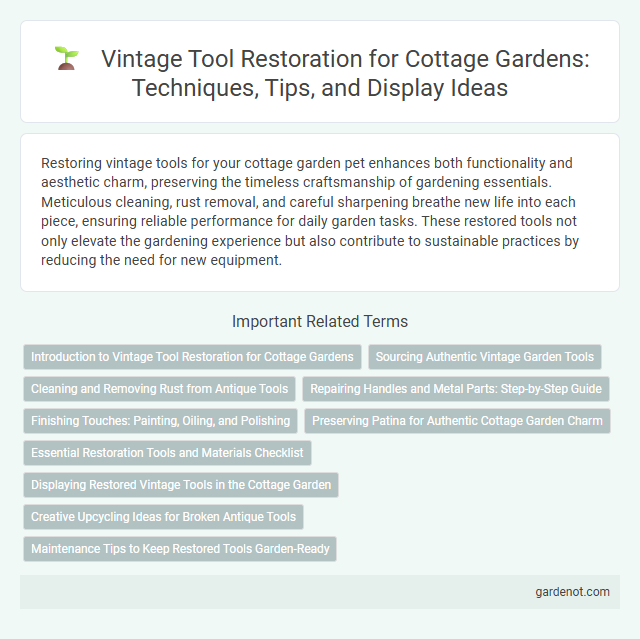Restoring vintage tools for your cottage garden pet enhances both functionality and aesthetic charm, preserving the timeless craftsmanship of gardening essentials. Meticulous cleaning, rust removal, and careful sharpening breathe new life into each piece, ensuring reliable performance for daily garden tasks. These restored tools not only elevate the gardening experience but also contribute to sustainable practices by reducing the need for new equipment.
Introduction to Vintage Tool Restoration for Cottage Gardens
Vintage tool restoration for cottage gardens involves carefully refurbishing aged gardening tools to preserve their historical charm while improving functionality. Techniques include rust removal, handle sanding, and blade sharpening using period-appropriate methods and materials to maintain authenticity. Restored tools not only enhance the aesthetic of a cottage garden but also provide durable, eco-friendly alternatives to modern equipment.
Sourcing Authentic Vintage Garden Tools
Sourcing authentic vintage garden tools requires careful research and connections with specialized antique dealers, flea markets, and estate sales. Identifying reputable sources ensures tools are genuine and retains their original craftsmanship and durability, which is essential for effective restoration. Proper authentication enhances the value and usability of these tools in maintaining a traditional cottage garden aesthetic.
Cleaning and Removing Rust from Antique Tools
Cleaning and removing rust from antique tools in a cottage garden involves using gentle abrasive materials like fine steel wool or a wire brush combined with rust dissolvers such as white vinegar or commercial rust removers. After rust removal, tools should be thoroughly dried and treated with linseed oil or a rust-preventive lubricant to preserve their metal surfaces and prevent future corrosion. Maintaining restored vintage tools enhances their functionality and extends their lifespan while preserving their historical value in garden settings.
Repairing Handles and Metal Parts: Step-by-Step Guide
Restoring vintage garden tools involves carefully repairing wooden handles by sanding, filling cracks with wood filler, and applying linseed oil to preserve durability. Metal parts require rust removal using steel wool or a wire brush, followed by coating with rust-resistant primer and paint to extend lifespan. Ensuring secure attachment of handles to metal components prevents loosening and enhances tool functionality for cottage garden maintenance.
Finishing Touches: Painting, Oiling, and Polishing
Restoring vintage gardening tools in a cottage garden involves precise finishing touches like painting, oiling, and polishing to protect and enhance their longevity. Applying rust-resistant paint preserves metal parts while maintaining an authentic aged look, and lightly oiling wooden handles prevents cracking from weather exposure. Polishing metal surfaces not only restores shine but also smooths rough edges, ensuring tools remain both functional and visually appealing.
Preserving Patina for Authentic Cottage Garden Charm
Restoring vintage garden tools while preserving their patina maintains the authentic charm essential to a classic cottage garden aesthetic. Carefully cleaning and oiling these tools without stripping away their aged patina retains their historical character and enhances the garden's nostalgic appeal. This approach not only extends the lifespan of the tools but also enriches the overall vintage ambiance treasured in traditional cottage garden settings.
Essential Restoration Tools and Materials Checklist
Essential restoration tools for vintage cottage garden tools include a wire brush, sandpaper, and rust remover to eliminate corrosion effectively. High-quality lubricants, steel wool, and a sturdy metal file ensure smooth operation and longevity after restoration. Protective gloves and a workbench with clamps provide safety and stability during the meticulous restoration process.
Displaying Restored Vintage Tools in the Cottage Garden
Restored vintage tools bring a rustic charm and historical aesthetic to the cottage garden, enhancing its overall ambiance. Strategically displaying these tools on weathered wooden racks or antique metal stands highlights their craftsmanship and preserves their legacy. Incorporating restored spades, hoes, and hand trowels into garden decor not only showcases their functional beauty but also connects the space to traditional gardening practices.
Creative Upcycling Ideas for Broken Antique Tools
Broken antique tools can be transformed into charming garden decor through creative upcycling techniques like converting rusted spades into rustic garden signs or old wrenches into unique plant hangers. Restoring vintage tools involves careful cleaning and refinishing to preserve their historical character while repurposing parts to create functional art pieces that enhance cottage garden aesthetics. Incorporating these restored items adds authenticity and a nostalgic touch, blending history with sustainable gardening practices.
Maintenance Tips to Keep Restored Tools Garden-Ready
Restoring vintage garden tools requires regular maintenance to keep them garden-ready, including thorough cleaning to remove rust and dirt after each use. Sharpen blades with a whetstone to maintain cutting efficiency and apply a light coat of linseed oil on wooden handles to prevent drying and cracking. Store tools in a dry, sheltered space to avoid moisture exposure and inspect metal parts regularly for early signs of corrosion or wear.
Vintage tool restoration Infographic

 gardenot.com
gardenot.com